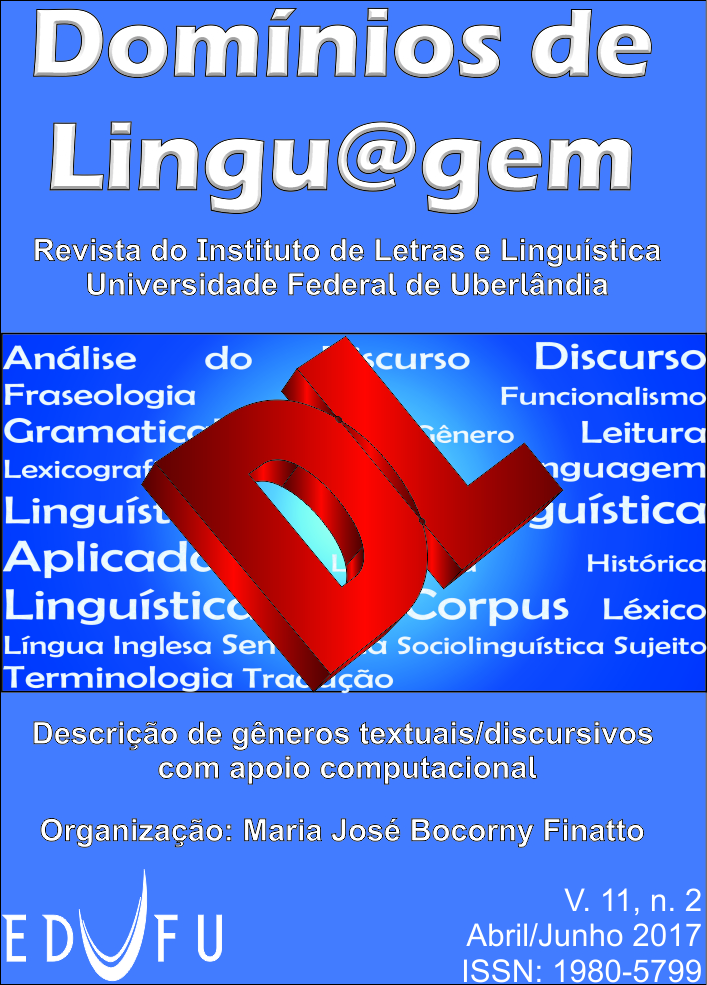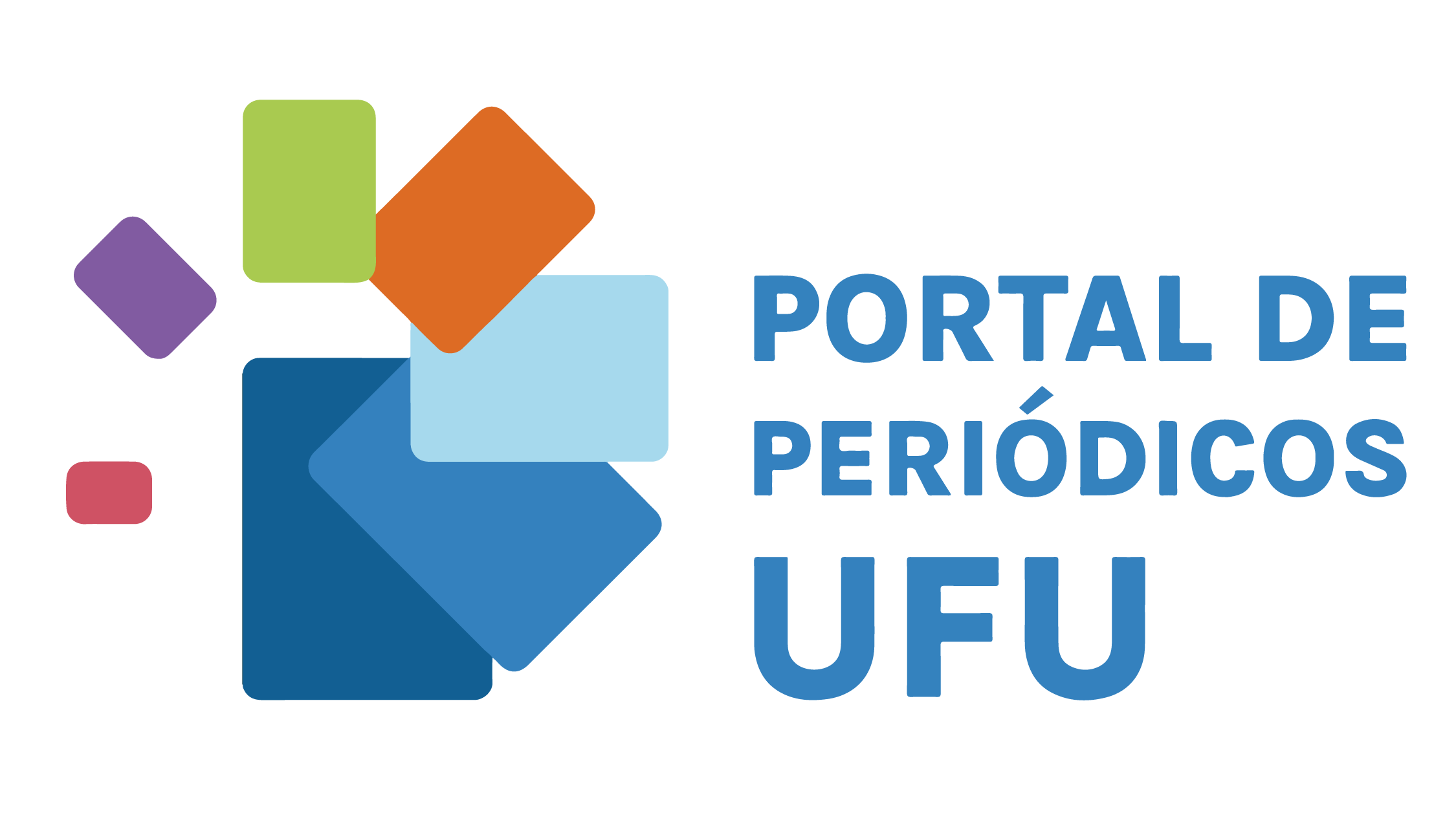Ideology in discursive genres by the associated analysis of the Systemic-Functional Linguistics and Corpus Linguistics
Galician-Portuguese chants
DOI:
https://doi.org/10.14393/DL29-v11n2a2017-7Keywords:
Discursive genres, . Systemic-Functional Linguistics, Corpus Linguistics, IdeologyAbstract
Recent linguistic research in the scope of Systemic-Functional Linguistics and Corpus Linguistics allowed major advances in understanding textual micro and macrostructure due to the growing concern to qualify quantitative data, especially lexicogrammatical choices and patterns of occurrence in genres. Therefore, the combination of methodological tools provided by the theoretical framework of both theories allows a comprehensive study of the text, since the cross-analysis of data might show significant standards of use of languages in order to recognize and use a given genre. In fact, the recurring disagreement about the definition of discursive genres is largely due to the relative stability of genres (cf. Bakhtin, 1992) that materialize at different linguistic levels. Ideology – assumed as a detectable and noticeable higher contextual dimension – is generally discredited in genres analysis, precisely because of its broad and multilevel characteristic, which makes data manipulation harder for the researcher. Therefore, this article proposes a cross-analysis, there is a theoretical-methodological association between the Systemic-Functional Linguistics and Corpus Linguistics in order to unveil the ideological complexes obtained from the patterns of occurrence of key participants (w-participants) in the discourse and the logogenetical meaning resulted from the representation of the experience (ideational metafunction) in Galician-Portuguese chants of love.Downloads
Metrics
References
ARTEMEVA, N. Approaches to learning genres: A bibliographical essay. In: ARTEMEVA, N.; FREEDMAN, A. Rhetorical genre studies and beyond. Winnipeg, Manitoba, Canada: Inkshed. p. 9-99, 2007.
BAKHTIN, M. Speech genres and other late essays. Austin: University of Texas Press, 1986.
______. Os gêneros do discurso. Estética da criação verbal, v. 4, p. 261-306, 1992.
BAZERMAN, C. Systems of genres and the enactment of social intentions. Genre and the new rhetoric, v. 79101, 1994.
BHATIA, V. K. Introduction: Genre analysis and world Englishes. World Englishes, v. 16, n. 3, p. 313-319, 1997. https://doi.org/10.1111/1467-971X.00066
______. Worlds of written discourse: A genre-based view. A&C Black, 2004.
______. Analysing genre: Language use in professional settings. Routledge, 2014.
BERKENKOTTER, C.; HUCKIN, T. Genre knowledge in disciplinary communities. Hillsdale, HJ: Lawrence Erlbaum, 1995.
BERBER-SARDINHA, T. Lingüística de corpus: histórico e problemática. Delta, v. 16, n. 2, p. 323-367, 1999.
______. O que é um corpus representativo. Direct Papers, v. 44, 2000.
BIBER, D. On the complexity of discourse complexity: A multidimensional analysis. Discourse Processes, v. 15, n. 2, p. 133-163, 1992. https://doi.org/10.1080/01638539209544806
BIBER, D; CONRAD, S. Lexical bundles in conversation and academic prose. Language and Computers, v. 26, p. 181-190, 1999.
BIBER, D.; CONNOR, U.; UPTON, T.A. Discourse on the move: Using corpus analysis to describe discourse structure. John Benjamins Publishing, 2007. https://doi.org/10.1075/scl.28
BIBER, D. et. al. Corpus linguistics – Investigating language structure and use. Cambridge: Cambridge University Press, 1998. https://doi.org/10.1017/CBO9780511804489
CERMAK, F. Czech National Corpus: A case in many contexts. International Journal of Corpus Linguistics, 2.2: 181-198, 1997. https://doi.org/10.1075/ijcl.2.2.03cer
CESCHIN, H. L. A educação do cavaleiro e a expressão do amor no trovadorismo In: Quaderni Nuova Serie - nº 10. v. 10, São Paulo: [s.n.], 1998. p. 139-173.
CLARK, K.; HOLQUIST, M. Mikhail Bakhtin. Boston: Harvard University Press, 1984.
EGGINS, S.; MARTIN, J. R. Genres and registers of discourse. Discourse as structure and process, v. 1, p. 230-256, 1997. https://doi.org/10.4135/9781446221884.n9
FAIRCLOUGH, N. Language and power. London; New York: Longman, 1992.
FAIRCLOUGH, N.; WODAK, R. Critical discourse analysis. In: VAN DIJK (T.). Discourse as Social Interaction. London: Sage, 1997.
FILLMORE, C. Corpus linguistics or computer corpus linguistics. Directions in corpus linguistics. Proceedings of Nobel symposium 82, Stockholm, Ed. Jan Svartvik, 35-60. Berlin/New York, De Gruyter, 1992.
FOWLER, R. The intervention of the media in the reproduction of power. Approaches to discourse, poetic and psychiatry, p. 67-80, 1987.
______. Language in the news: Discourse and ideology in the press. London: Routledge, 1991.
______. Linguistic criticism. (2ª ed.). Oxford: Oxford UP, 1996a.
______. On critical linguistics. Texts and practices: Readings in critical discourse analysis, p. 1, 1996b.
GUERREIRO, M. V. Para a história da literatura popular portuguesa. Inst. de Cultura e Língua Portuguesa, Min. da Educação e Cultura, 1978.
GOFFMAN, E. Frame analysis. New York: Harper Colophon Books, 1974.
GRANGER, S. (Org.) Learner English on Computer. New York: Longman, 1998.
HALLIDAY, M. A. K. An Introduction to Functional Grammar. (2ªed.). London: Edward Arnold, 1994.
HALLIDAY, M. A. K.; HASAN, R. Language, context and text. Aspects of language in a social-semiotic perspective. 2ªed. London: Oxford University Press, 1989.
HALLIDAY, M. A. K.; MARTIN, J. R. Writing Science: literacy and discursive power. London/Washington: The Falmer Press, 1993.
HALLIDAY, M. A. K.; MATHIESSEN, M. I. M. An introduction to functional grammar. (3ªed.). London: Arnold, 2004.
HASAN, R. Speech genre, semiotic mediation and the development of higher mental functions. Language Sciences, v. 14, n. 4, p. 489-528, 1992. https://doi.org/10.1016/0388-0001(92)90027-C
_______. The uses of talk. Discourse and social life, p. 28-47, 2000.
HYLAND, K. Genre-based pedagogies: A social response to process. Journal of second language writing, v. 12, n. 1, p. 17-29, 2003. https://doi.org/10.1016/S1060-3743(02)00124-8
HYON, S. Genre in three traditions: Implications for ESL. TESOL quarterly, v. 30, n. 4, p. 693-722, 1996. https://doi.org/10.2307/3587930
JAKOBSON, R.; BOAS, F. Franz Boas' approach to language. International Journal of American Linguistics, v. 10, n. 4, p. 188-195, 1944. https://doi.org/10.1086/463841
KRESS, G. Learning to write. London, Routledge & Kegan, 1982.
______. Multimodality, Multimedia, and Genre.”. Visual rhetoric in a digital world, p. 38-54, 2004.
LEECH, G. English in advertising: a linguistic study of advertising in Great Britain. London: Longman, 1966.
______. Reading images: Multimodality, representation and new media. Information Design Journal, v. 12, n. 2, p. 110-119, 2004. https://doi.org/10.1075/idjdd.12.2.03kre
LI, J. Transitivity and lexical cohesion: Press representations of a political disaster and its actors. Journal of Pragmatics, v. 42.12. 2010. p. 3444-3458. https://doi.org/10.1016/j.pragma.2010.04.028
LOPES, G.V et al. Cantigas Medievais Galego Portuguesas [base de dados online]. Lisboa: Instituto de Estudos Medievais, FCSH/NOVA. Disponível em: http://cantigas.fcsh.unl.pt. Consulta em: 01 nov. 2016.
MARTIN, J. R. et al. Language, register and genre. Children writing: reader, v. 1, p. 984, 1984.
______. Process and text: two aspects of human semiosis. Systemic perspectives on discourse, v. 1, n. 15, p. 248-274, 1985.
______. Genre and literacy-modeling context in educational linguistics. Annual review of applied linguistics, v. 13, p. 141-172, 1992. https://doi.org/10.1017/S0267190500002440
______. Analysing genre: functional parameters. In. JR Martin. Genre and institutions: Social processes in the workplace and school, p. 3, 2005.
MILLER, C. R. The cultural basis of genre. In: Genre and the new rhetoric. 1994.
OLIVEIRA, Ulisses Tadeu Vaz de et al. O fenhedor e o precador nas cantigas líricas galego-portuguesas de D. Dinis: uma perspectiva sistêmico-funcional. 2008. 162 f. Dissertação (Mestrado). LAEL, Pontifícia Universidade Católica, São Paulo, 2008.
PALTRIDGE, B. Genre, text type, and the English for Academic Purposes (EAP) classroom. Genre in the classroom: Multiple perspectives, p. 73-90, 2002.
REYNOLDS, M. The blending of narrative and argument in the generic texture of newspaper editorials. International Journal of Applied Linguistics,10.1,2000, p. 25-40.
SÁNCHEZ, A. Cumbre: corpus lingüístico del español contemporáneo: fundamentos, metodología y aplicaciones. Sociedad General Española de Librería, 1995.
SCOTT, M. WordSmith tools. Oxford: Oxford University Press, 1996.
SINCLAIR, J. McH. Beginning the study of lexis. In: C. E. BAZELL (org.). In Memory of J. R. Firth. London: Longman, 1966.
_____. Collocation: a progress report. In: R. STEELE & T. THREADGOLD (org.). Language topics – Essays in honour of Michael Halliday (Vol. 2). Amsterdam/Philadelphia: John Benjamins, 1987.
SINCLAIR, J. Corpus, Concordance, Collocation. Oxford: Oxford University Press, 1991.
SVARTVIK, J. (Org.) Directions in Corpus Linguistics: Proceedings of Nobel Symposium 82 – Stockholm, 4-8 August 1991 (Trends in Linguistics – Studies and Monographs: 65). Berlin, New York: Mouton De Gruyter, 1992.
SPINA, S. A lírica trovadoresca. 3ª ed. São Paulo: Edusp, 1996.
SWALES, J. Genre analysis: English in academic and research settings. Cambridge University Press, 1990.
THOMPSON, G. Introducing Functional Grammar. London: Arnold,1996.
________. Resonance in text. In: SANCHEZ-MACARRO & CARTER, R. (eds.) Linguistic choice across genres: variation in spoken and written English. London: John Benjamins, 1998. https://doi.org/10.1075/cilt.158.05tho
THORNDIKE, E. L. Teacher’s Wordbook. New York: Columbia Teachers College, 1921.
VAN DIJK, T. A. Structures of news in the press. Discourse and communication, p. 69-93, 1985.
______. Discourse studies: a multidisciplinary introduction. v.1 London: Sage, 1997. https://doi.org/10.4135/9781446221884.n1
______. Cognição, discurso e interação. São Paulo: Contexto, 1999.
YUNICK, S. Genres, registers and sociolinguistics. World Englishes, v. 16, n. 3, p. 321-336, 1997. https://doi.org/10.1111/1467-971X.00067
ZHOU, Q.; YU S. Annotating the Contemporary Chinese Corpus. International Journal of Corpus Linguistics, 2.2: 199-238, 1997. https://doi.org/10.1075/ijcl.2.2.05qia
Downloads
Published
How to Cite
Issue
Section
License
Authors who publish in this journal agree to the following terms:
Authors retain the copyright and waiver the journal the right of first publication, with the work simultaneously licensed under the Creative Commons Attribution License (CC BY-NC-ND 4.0), allowing the sharing of work with authorship recognition and preventing its commercial use.
Authors are authorized to take additional contracts separately, for non-exclusive distribution of the version of the work published in this journal (publish in institutional repository or as a book chapter), with acknowledgment of authorship and initial publication in this journal.









